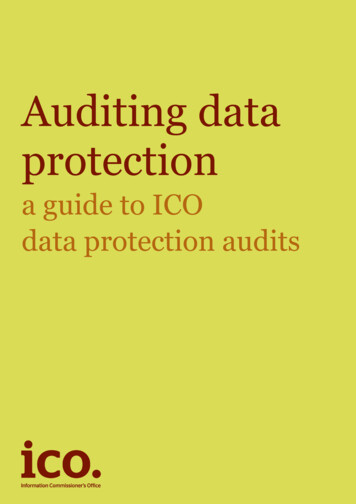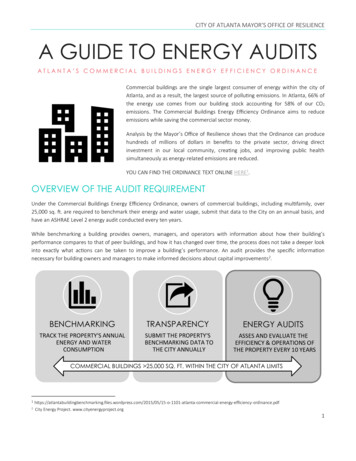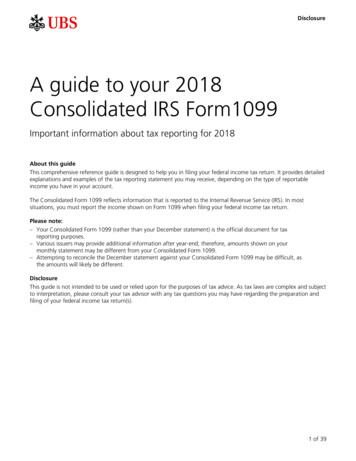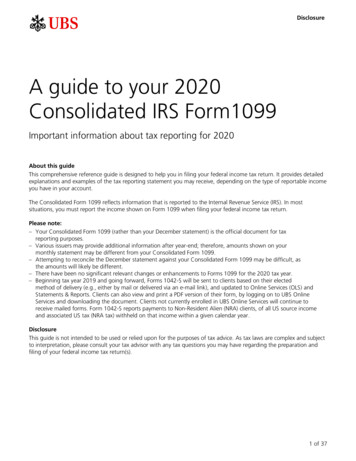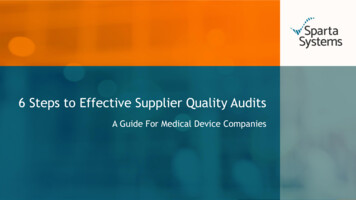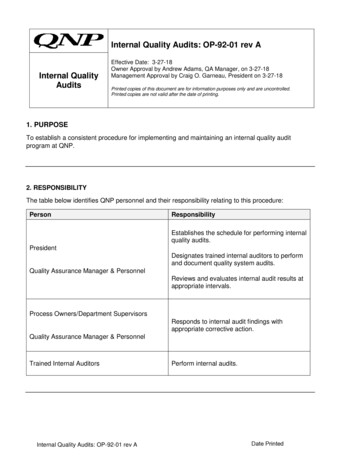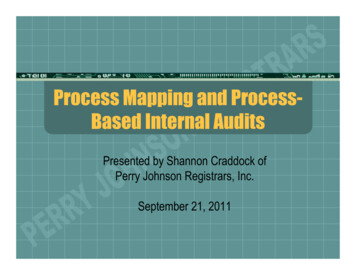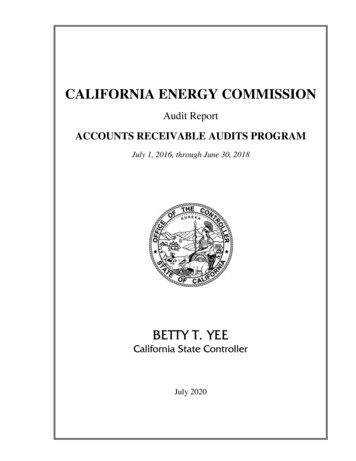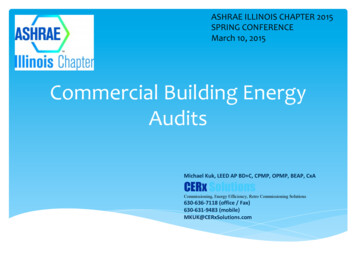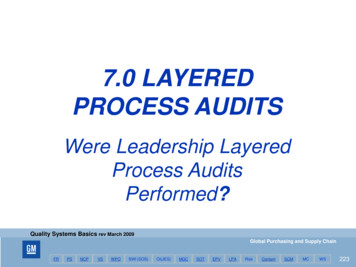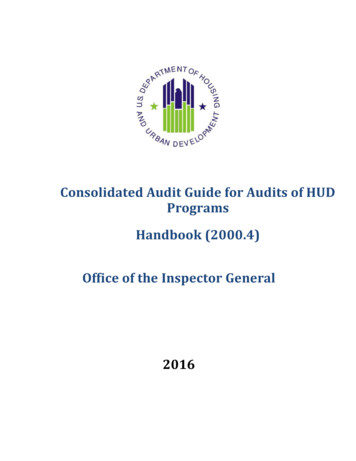
Transcription
Consolidated Audit Guide for Audits of HUDProgramsHandbook (2000.4)Office of the Inspector General2016
2000.04 REV-2 CHG-20ParagraphPageTable of Contents1.GENERAL AUDIT GUIDANCE1-12.REPORTING REQUIREMENTS AND SAMPLE REPORTS2-13.HUD MULTIFAMILY HOUSING PROGRAMS3-14.MORTGAGE INSURANCE FOR HOSPITALS PROGRAM4-15.INSURED DEVELOPMENT COST CERTIFICATION AUDIT GUIDANCE5-16.GINNIE MAE ISSUERS OF MORTGAGED-BACXED SECURITIESAUDIT GUIDANCE6-1FHA-APPROVED LENDERS AUDIT GUIDANCE7-17.APPENDIXi12/01
2000.04 REV-2 CHG-17CHAPTER 1.1-1.GENERAL AUDIT GUIDANCEPurpose. This audit guide is to assist the independent auditor (auditor) in performingaudits of profit-motivated entities that are subject to the U.S. Department of Housing andUrban Development’s (HUD) uniform financial reporting standards set forth in 24 CFR(Code of Federal Regulations) Part 5, Subpart H; and 24 CFR Part 202.5(g) and relatedmortgagee letters. HUD requires an audit that consists of two components: a financialstatement audit of the entity and a compliance audit of the entity’s major HUD programs.The audit must be performed in accordance with generally accepted auditing standards(GAAS), issued by the American Institute of Certified Public Accountants (AICPA), andgenerally accepted government auditing standards (GAGAS), issued by the ComptrollerGeneral of the United States. For Securities and Exchange Commission registrants, thefinancial statement audit may be performed in accordance with the standards of thePublic Company Accounting Oversight Board (PCAOB) and GAGAS. Additionally, thecompliance audit is to be conducted in accordance with this audit guide, which requiresthat the auditor perform procedures that enable the auditor to opine on whether the entityhas complied with laws, regulations, and the provisions of contracts or grant agreementsapplicable to its major HUD programs.The use of this audit guide is mandatory for audits of all for-profit participants; however,this audit guide is not intended to be a complete manual of audit procedures for thecompliance audit. The audit guide is not intended to cover all situations that may exist orreplace the auditor’s judgment of audit work required to meet GAAS and GAGAS. It ismeant to supplement those standards with information specific to HUD programs.Suggested audit procedures contained herein might not cover all circumstances orconditions encountered in a particular audit. The auditor should use professionaljudgment to tailor the procedures so that the audit objectives are met. However, auditorsmust address all compliance requirements in this audit guide that could have a direct andmaterial effect on a major HUD-assisted program. If the auditor determines that certainprocedures for a compliance requirement will not to be performed, the rationale for theexclusion must be explained and documented in the audit documentation in support of theauditor’s report. An example would be a situation in which circumstances pertaining tothe auditee are such that the auditee is not subject to a particular requirement.This audit guide is divided into chapters. This chapter, chapter 1, documents the purpose,background, and requirements for performing a HUD-required audit. It also includesother matters the auditor should consider in preparing for the audit. Chapter 2 containsthe reporting requirements. Both chapters 1 and 2 apply to all audits covered by thisaudit guide. Each of the remaining chapters contains procedures for auditing compliancewith specific HUD program requirements.Chapters 3 through the remainder of the guide contain references to relevant compliancerequirements that were in effect at the time each chapter was issued. Auditors shouldrecognize that compliance requirements change periodically and that delays will occurbetween such changes and revisions to this audit guide. Moreover, auditors should5/20131-1
2000.04 REV-2 CHG-17recognize that there may be provisions of contracts and grant agreements that are notspecified in law, regulation, or other HUD requirements contained in HUD handbooks,notices, and mortgagee letters; therefore, the specifics of such are not included in thisaudit guide. Accordingly, the auditor should perform reasonable procedures to ensurethat compliance requirements are current and to determine whether there are anyadditional provisions of contracts and grant agreements that should be covered by anaudit under this audit guide. Reasonable procedures would be inquiry of auditeemanagement and review of the contracts and grant agreements for major programs. HUDdocuments are available in the HUD Client Information and Policy System(HUDCLIPS), at the following Internet address:http://portal.hud.gov/hudportal/HUD?src /program offices/administration/hudclips/If the auditor desires technical assistance pertaining to HUD programs, regulations, oroperations, the auditor should contact the particular HUD headquarters or field programoffices listed in the applicable chapter or contact the office responsible for monitoring oroverseeing the activities of the auditee.1-2.Use of This Audit Guide for Audits of States, Local Governments, and NonprofitOrganizations. Governmental and nonprofit entities also participate in some of theHUD programs covered in chapters 3 through 7 of this audit guide. These entities aresubject to the audit requirements in Office of Management and Budget (OMB) CircularA-133, and auditors should normally use OMB’s Compliance Supplement to perform theaudit and not this audit guide. However, in instances in which a program is not includedin the OMB Compliance Supplement but is covered in this audit guide, the auditor shoulduse the compliance requirements and suggested audit procedures in this audit guide forpurposes of building an audit program using the guidance in part 7 of the OMBCompliance Supplement.1-3.Audit Scope and Approach.A. Financial Statement Audit.The financial statement audit should be planned to be sufficiently comprehensive inscope to permit an expression of an opinion on the financial statements and an inrelation-to opinion on the supplementary information of the HUD-assisted activity asreferenced in the relevant chapters in this audit guide.GAAS requires that a sufficient understanding of internal controls be obtained to planthe audit and to determine the nature, timing, and extent of tests to be performed. Infulfilling the audit requirement relating to an understanding of internal controls andassessing the level of control risk, the auditor should follow, at a minimum, theguidance contained in the AICPA’s Codification of Statements on Auditing Standards(AU-C) Section 315, “Understanding the Entity and Its Environment and Assessing5/20131-2
2000.04 REV-2 CHG-17the Risks of Material Misstatement.” GAGAS provides an additional requirement forreporting on internal control over financial reporting (see chapter 2 of this auditguide).B. Compliance Audit.This audit guide requires an opinion on the auditee’s compliance with specificrequirements applicable to each major program included in the audit. The auditorshould use the following information to determine whether a program is considered tobe a major program for the type of audit being performed using a specific audit guidechapter. Chapters 3 and 4: A major program is defined as an individual assistanceprogram for which expenditures equaled or exceeded 500,000 during theapplicable year or a project or hospital that had an outstanding HUD-insuredor HUD-guaranteed loan balance equal to or exceeding 500,000 as of the endof the period under audit. Chapter 5: No major program designation is needed. Chapter 6: A Government National Mortgage Association (Ginnie Mae)issuer’s Ginnie Mae program is considered major if the issuer had a servicingportfolio or had any remaining principal balance at the end of the audit period. Chapter 7: A Federal Housing Administration (FHA)-approved lender’sprogram is considered major regardless of the amount of loans originated orserviced during the period under audit. However, for lenders havingcombined originations and a servicing portfolio of less than 2 million, theopinion on compliance need cover only the compliance requirements inchapter 7, section 7-5(A), Quality Control Plan, and 7-5(G), Lender AnnualRecertification, Adjusted Net Worth, Liquidity, and Licensing.The auditor is also to consider the auditee’s internal control over compliance as partof the compliance audit. The audit documentation should clearly demonstrate theauditor’s understanding and assessment of control risk related to internal controlsover compliance established for HUD-assisted activities. When auditing HUDprograms, the auditor should perform tests of controls to evaluate the effectiveness ofthe design and operation of internal controls in preventing or detecting materialnoncompliance with the direct and material requirements of the major HUD-assistedprograms. The auditor should perform these procedures regardless of whether theauditor assesses the internal control risk to be below the maximum. The stepsperformed and conclusions reached should be clearly stated in the auditdocumentation. Tests may be omitted only in areas in which internal controls arelikely to be ineffective in preventing or detecting noncompliance; in which case,instances of the deficiencies are to be reported as findings.5/20131-3
2000.04 REV-2 CHG-171-4.Sample Selection.Audit sampling, when properly applied, can provide sufficient appropriate evidence tosupport the audit opinion. Audit sampling is defined as the application of an auditprocedure to less than 100 percent of the items within a population. The auditor usesprofessional judgment in planning, performing, and evaluating a sample and in relatingthe audit evidence produced by the sample to other audit evidence when forming aconclusion.It is important that the sample selected be representative of the population. The size of asample necessary to provide sufficient audit evidence depends on both the objectives andthe efficiency of the sample. Because of the previous inconsistency in the application ofthe sampling process in auditing HUD programs, the Office of Inspector General (OIG)convened a panel consisting of representatives from OIG, HUD’s Real Estate AssessmentCenter, the AICPA, and several auditing firms with significant HUD experience todiscuss the issue and potential solutions. All participants agreed that attribute sampling isthe appropriate sampling methodology for use in auditing programs using this guide toprovide consistency and ensure adequate coverage to support the audit opinions rendered.This sampling approach has since been endorsed by the AICPA in its Audit Guide forGovernment Auditing Standards and A-133 Audits.Whenever a sample is selected to test compliance or to test controls over compliance aspart of an audit performed in accordance with this guide, HUD requires that an attributesampling methodology be used. This requirement is to provide consistency and ensureadequate coverage to support the audit opinions rendered. Appendix A to chapter 1 ofthis guide, “Attribute Sampling,” applies to all audits performed in accordance with thisguide. It provides additional information on attribute sampling and minimum samplesizes. The sample sizes stated in appendix A are mandatory and are the minimum samplesizes to be used for all samples selected.Further information about applying attribute sampling in an audit of Federal programscan be found in the AICPA’s Audit Guide for Government Auditing Standards andA-133 Audits. Auditors may substitute an approach from the AICPA’s audit guide forthe approach described in appendix A, provided that the resulting sample size is equal toor greater than the minimum sample sizes in appendix A.1-5.Planning the Audit.A. Engagement Letter. A written letter of engagement between the auditee and theauditor is required and must contain the following mandatory information:1.That the audit is to be performed in accordance with GAAS; GAGAS; and thecurrent version of HUD’s audit guide, HUD Handbook 2000.04.5/20131-4
2000.04 REV-2 CHG-172.The estimated date the audit report will be delivered to the auditee. Goodcoordination between the auditee and auditor is important to ensure timelydelivery of the audit report, considering that managers from HUD may hold upadvances and other funding approvals, etc., until the audit report is received.Note that it is the auditee’s responsibility to ensure that the audit is completedwithin the time requirements set forth in its contracts or agreements with HUDand that the conditions stated in the engagement letter are met. However, theauditor should consider the causes for any delays to determine whether they formthe basis for an audit finding.3.That the auditor is required to provide the HUD Secretary or his or her designee,the HUD Inspector General, and the U.S. Government Accountability Office(GAO) or their representatives access to audit documentation or any otherdocuments needed to review the audit (hardcopy or electronic). Access to auditdocumentation by HUD and GAO representatives includes making necessaryphotocopies of hardcopy audit documentation or other documents or electroniccopies of electronic audit documentation.4.That if the auditor becomes aware of noncompliance with provisions of laws,regulations, contracts, and grant agreements or fraud that has occurred or islikely to occur, the auditor is required to bring such acts to the attention of theappropriate level of management. In addition, as required in chapter 2 of thisaudit guide, the auditor may be required to contact the HUD single auditcoordinator to discuss matters relating to fraud or equity skimming. Based onthat discussion, the auditor may be requested to prepare a written report on allknown or likely fraud that has occurred. Acceptance of the engagement lettergrants the auditor permission to contact the HUD single audit coordinator anddiscuss the conditions noted.5.That if the program being audited requires electronic submission of the financialand compliance data to HUD, the responsibilities of the auditor and the auditeeshould be included as follows:a. The auditee is responsible for making the electronic submission to HUD.b. The auditor under a separate agreed-upon procedure engagement isresponsible for applying procedures to ensure that the data submitted agreewith the auditee’s hardcopies of the supporting documentation.6.A description of the scope of the planned audit and contents of the report as setforth in chapter 2 of the audit guide.7.If applicable, that the auditee grants permission for the successor auditor todiscuss and review the predecessor auditor’s audit documentation and for the5/20131-5
2000.04 REV-2 CHG-17auditee to make the appropriate arrangements. Normally the auditor, beforeissuing an engagement letter, will contact the predecessor auditor to review thepredecessor auditor’s audit documentation files supporting the prior financialstatement audit and any findings included in the predecessor auditor’scompliance report. The auditor may also need to discuss with the predecessorauditor matters that are not adequately explained or documented in the auditdocumentation or a preexisting condition the auditor notes in his or her reviewthat was not in the prior audit report. If the predecessor auditor refuses to allowthe successor auditor access to that information or to discuss such matters, thesuccessor auditor should include in the engagement letter that the auditee grantspermission for the successor auditor to discuss and review the prior auditdocumentation and for the auditee to make the appropriate arrangements.8.A list of the information the auditor wants the auditee to provide for the auditand the requested delivery date of those items.B. Testing. The auditor should use professional judgment to determine the extent oftesting necessary to support his or her opinion on the auditee’s financial statementsand to report on the auditee’s internal controls and on compliance with applicablelaws and regulations. A dual-purpose sample may be used for testing compliance andinternal controls over compliance. When a single sample is used to meet more thanone audit objective, testing for each audit objective must follow the minimum samplesize requirements. All compliance requirements contained in this audit guide thatrelate to a major program must be addressed.For audits of entities subject to chapter 3 of the guide, please refer to that chapter fortesting considerations in situations in which the project is owned or managed by anentity that owns or manages multiple HUD-assisted projects.C. Reporting. Please refer to chapter 2. The applicable HUD program officeestablishes the due dates for submission of the audit reporting package to HUD andgenerally will not grant exceptions except in extraordinary circumstances. Requeststo extend the due date for submission of the audit reporting package should not bedirected to OIG.D. Management Representations.The auditor is required to obtain writtenrepresentations from management that include matters concerning compliance withprogram laws and regulations that have a material effect on the financial statementsand each HUD-assisted program and all compliance violations or issues regardless oftheir materiality, as well as management’s responsibilities for establishing andmaintaining effective control over financial reporting and internal control overcompliance.E. Audit Documentation. The auditor must retain audit documentation (previouslyreferred to as audit working papers) and reports for a minimum of 6 years from the5/20131-6
2000.04 REV-2 CHG-17submission of the audit report to HUD, unless the auditor is notified in writing byHUD or GAO to extend the retention period. When an auditor becomes aware thatHUD or the auditee is contesting an audit finding in the report, the auditor maycontact the single audit coordinator for further guidance regarding the length of timethe related audit documentation should be held before destruction of that auditdocumentation and report.1-6.Withdrawal From or Termination of an Engagement. On occasion, an auditor’sengagement may be terminated by the auditee after the audit is initiated, or the auditormay withdraw from the engagement. This termination or withdrawal could occur for anumber of reasons. When this happens, the auditor is to advise the OIG single auditcoordinator and the HUD servicing program office in writing. The written notification(letter or report) is to provide a detailed explanation for the withdrawal or termination. Iffraud or equity skimming that may exist is the reason for the withdrawal or termination,the auditor is to follow the guidance in paragraph 2-5 of chapter 2 of this audit guide.The following are the officials who are to be notified based on the audit guide chapterbeing used to audit the HUD-funded activity.Program auditedbased on auditguide chapter no.Official to be contactedDeputy Assistant Secretary for Multifamily Housing34Deputy Assistant Secretary for Healthcare Programs (for audits ofnursing homes, intermediate care facilities, and board and carehomes with mortgages insured under Section 232 of the NationalHousing Act)Deputy Assistant Secretary for Healthcare ProgramsDeputy Assistant Secretary for Multifamily Housing5Deputy Assistant Secretary for Healthcare Programs (for audits ofnursing homes, intermediate care facilities, and board and carehomes with mortgages insured under Section 232 of the NationalHousing Act)6Executive Vice President of Ginnie Mae7Director, Office of Lender Approval and Recertification Division3 through 7HUD OIG Single Audit Coordinator5/20131-7
2000.04 REV-2 CHG-17Contact information for the positions listed above can be found on HUD’s Internet site.HUD OIG’s Single Audit Coordinator can be contacted at the following email address:HUDOIGSingleAuditCoordinator@hudoig.gov1-7
1-2. Use of his T Audit Guide for Audits of States, Local Governments, and Nonprofit Organizations. Governmental and nonprofit entities also participate in some of the HUD programs covered in chapters 3 through 7 of this . These entities are audit guide subject to the audit requirements in Office of anagement and M udgetB (OMB) Circular
